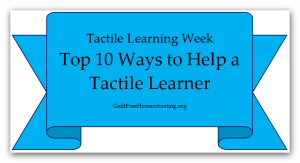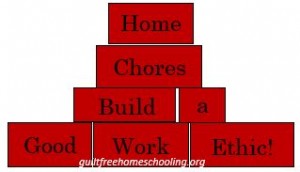 These tips will be helpful for parents of younger tactile students, who need help learning how to learn.
These tips will be helpful for parents of younger tactile students, who need help learning how to learn.
1. Allow him to hold a favorite object during lessons, especially if the lesson doesn’t include manipulatives or other hands-on aspects.
2. Allow plenty of free-play time with manipulatives before the lessons begin, so that he becomes completely familiar with the objects and will be less distracted by them during the lesson. The tactile learner will discover amazing things about spatial relationships, length, width, perimeter, area, volume, and balance just from grouping, regrouping, stacking, and lining up the pieces. You can supply the vocabulary words later.
3. Use manipulatives for every possible subject: letter tiles for spelling, phonics, vocabulary, or reading practice, number tiles for math problems, jigsaw puzzle-maps for geography, and whatever else comes to mind. Combine the pieces from several board games, and use them for sorting by color, shape, or size. Then challenge your older students to figure out the percentage of pieces that are red.
4. Allow him to partake in experiments and demonstrations. Getting his hands involved will help him learn the most.
5. Incorporate textures into manipulatives by using sandpaper, textured scrapbooking papers, textured craft foam, etc. Give those curious fingers plenty of good “reading material” – his brain will remember the facts connected to the textures. (Include the student in choosing the textures, since tactile learners’ fingers like some textures and dislike others.)
6. Build 3-dimensional models (whether with Legos, a shoebox diorama, or a snow fort) instead of 2-dimensional diagrams. The tactile learner benefits most from seeing all sides of a model, not just a flat representation. (Precisely accurate scale and colors are not required.)
7. No matter what it is, let him touch it and take time to handle it. Whether at home or in public places, your tactile learner needs to touch and feel and run his hands over any surface that interests him. And he’ll be learning. (Frequent involvement of hands and fingers on a daily basis means he will be more understanding of the admonition to not touch everything at the next special outing or museum.)
8. Let him experiment with alternative writing materials to find the most desirable combination of writing implement and writing surface. A whiteboard and dry-erase markers offer an entirely different feel from paper and crayons.
9. Keep his hands and fingers busy to help his brain absorb information. If his hands are empty and his fingers can’t move, he’s not going to learn. Think of it as though his fingers have just become deaf and blind, and you can appreciate the information his fingers absorb.
10. Give him experiences in the other 3 styles to improve his overall learning abilities
For further help, visit these links:
Learning Styles v. It’s a Syndrome
“Tactile Learning” topic (including all of this “Tactile Learning Week” series)
“Learning Styles” topic


















 Guilt-Free Homeschooling is the creation of Carolyn Morrison and her daughter, Jennifer Leonhard. After serious disappointments with public school, Carolyn spent the next 11 years homeschooling her two children, from elementary to high school graduation and college admission. Refusing to force new homeschooling families to re-invent the wheel, Carolyn and Jennifer now share their encouragement, support, tips, and tricks, filling their blog with "all the answers we were looking for as a new-to-homeschooling family" and making this website a valuable resource for parents, not just a daily journal. Guilt-Free Homeschooling -- Equipping Parents for Homeschooling Success!
Guilt-Free Homeschooling is the creation of Carolyn Morrison and her daughter, Jennifer Leonhard. After serious disappointments with public school, Carolyn spent the next 11 years homeschooling her two children, from elementary to high school graduation and college admission. Refusing to force new homeschooling families to re-invent the wheel, Carolyn and Jennifer now share their encouragement, support, tips, and tricks, filling their blog with "all the answers we were looking for as a new-to-homeschooling family" and making this website a valuable resource for parents, not just a daily journal. Guilt-Free Homeschooling -- Equipping Parents for Homeschooling Success!

Recent Comments